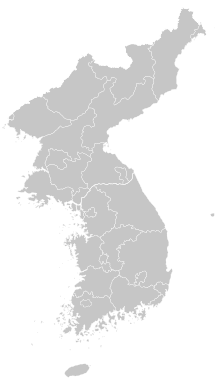Battle of Cheongju
| The Battle of Cheongju | |||||||
|---|---|---|---|---|---|---|---|
| Part of Imjin War | |||||||
| |||||||
| Belligerents | |||||||
| Japanese Army | Korean monks and irregulars | ||||||
| Commanders and leaders | |||||||
| Hachisuka Iemasa |
Jo Heon Yeonggyu | ||||||
| Strength | |||||||
| Unknown |
1,600[1] 1,000 monks[1] | ||||||
| Casualties and losses | |||||||
| Unknown | Unknown | ||||||
Location within South Korea | |||||||
The Battle of Cheongju was during the Japanese invasions of Korea (1592–98). Jo Heon attacked the Japanese-held city of Cheongju and captured it on 6 September 1592.[1]
Background
[edit]Jo Heon and the monk Yeonggyu gathered a force of 2,600 to attack Cheongju, which served as the administrative center of central Korea and contained a large government granary. It was previously taken on 4 June and was under the control of Hachisuka Iemasa.[1]
Battle
[edit]When the Koreans attacked, some of the Japanese were still out foraging for food. The Japanese came out and fired at the Koreans, but they were surrounded and killed. The Koreans didn't know how to use the matchlock firearms, so they used them as clubs. At this point a heavy downpour started so the Koreans fell back and retreated.[1]
The next day the Koreans discovered the Japanese had evacuated from Cheongju and took the city without a fight.[1]
Aftermath
[edit]With Cheonju secured the Koreans moved on towards Geumsan.[1]
References
[edit]Bibliography
[edit]- Alagappa, Muthiah (2003), Asian Security Order: Instrumental and Normative Features, Stanford University Press, ISBN 978-0-8047-4629-8
- Arano, Yasunori (2005), The Formation of a Japanocentric World Order, International Journal of Asian Studies
- Brown, Delmer M. (May 1948), "The Impact of Firearms on Japanese Warfare, 1543–1598", The Far Eastern Quarterly, 7 (3): 236–53, doi:10.2307/2048846, JSTOR 2048846, S2CID 162924328
- Eikenberry, Karl W. (1988), "The Imjin War", Military Review, 68 (2): 74–82
- Ha, Tae-hung; Sohn, Pow-key (1977), 'Nanjung Ilgi: War Diary of Admiral Yi Sun-sin, Yonsei University Press, ISBN 978-89-7141-018-9
- Haboush, JaHyun Kim (2016), The Great East Asian War and the Birth of the Korean Nation
- Hawley, Samuel (2005), The Imjin War, The Royal Asiatic Society, Korea Branch/UC Berkeley Press, ISBN 978-89-954424-2-5
- Jang, Pyun-soon (1998), Noon-eu-ro Bo-nen Han-gook-yauk-sa 5: Gor-yeo Si-dae (눈으로 보는 한국역사 5: 고려시대), Park Doo-ui, Bae Keum-ram, Yi Sang-mi, Kim Ho-hyun, Kim Pyung-sook, et al., Joog-ang Gyo-yook-yaun-goo-won. 1998-10-30. Seoul, Korea.
- Kim, Ki-chung (Fall 1999), "Resistance, Abduction, and Survival: The Documentary Literature of the Imjin War (1592–8)", Korean Culture, 20 (3): 20–29
- Kim, Yung-sik (1998), "Problems and Possibilities in the Study of the History of Korean Science", Osiris, 2nd Series, 13: 48–79, doi:10.1086/649280, JSTOR 301878, S2CID 143724260
- 桑田忠親 [Kuwata, Tadachika], ed., 舊參謀本部編纂, [Kyu Sanbo Honbu], 朝鮮の役 [Chousen no Eki] (日本の戰史 [Nihon no Senshi] Vol. 5), 1965.
- Neves, Jaime Ramalhete (1994), "The Portuguese in the Im-Jim War?", Review of Culture, 18: 20–24
- Niderost, Eric (June 2001), "Turtleboat Destiny: The Imjin War and Yi Sun Shin", Military Heritage, 2 (6): 50–59, 89
- Niderost, Eric (January 2002), "The Miracle at Myongnyang, 1597", Osprey Military Journal, 4 (1): 44–50
- Park, Yune-hee (1973), Admiral Yi Sun-shin and His Turtleboat Armada: A Comprehensive Account of the Resistance of Korea to the 16th Century Japanese Invasion, Shinsaeng Press
- Rockstein, Edward D. (1993), Strategic And Operational Aspects of Japan's Invasions of Korea 1592–1598 1993-6-18, Naval War College
- Sadler, A. L. (June 1937), "The Naval Campaign in the Korean War of Hideyoshi (1592–1598)", Transactions of the Asiatic Society of Japan, Second Series, 14: 179–208
- Sansom, George (1961), A History of Japan 1334–1615, Stanford University Press, ISBN 978-0-8047-0525-7
- Sohn, Pow-key (April–June 1959), "Early Korean Painting", Journal of the American Oriental Society, 79 (2): 96–103, doi:10.2307/595851, JSTOR 595851
- Stramigioli, Giuliana (December 1954), "Hideyoshi's Expansionist Policy on the Asiatic Mainland", Transactions of the Asiatic Society of Japan, Third Series, 3: 74–116
- Strauss, Barry (Summer 2005), "Korea's Legendary Admiral", MHQ: The Quarterly Journal of Military History, 17 (4): 52–61
- Swope, Kenneth M. (2006), "Beyond Turtleboats: Siege Accounts from Hideyoshi's Second Invasion of Korea, 1597–1598", Sungkyun Journal of East Asian Studies, 6 (2): 177–206
- Swope, Kenneth M. (2005), "Crouching Tigers, Secret Weapons: Military Technology Employed During the Sino-Japanese-Korean War, 1592–1598", The Journal of Military History, 69: 11–42, doi:10.1353/jmh.2005.0059, S2CID 159829515
- Swope, Kenneth M. (December 2002), "Deceit, Disguise, and Dependence: China, Japan, and the Future of the Tributary System, 1592–1596", The International History Review, 24 (4): 757–1008, doi:10.1080/07075332.2002.9640980, S2CID 154827808
- Swope, Kenneth M. (2009), A Dragon's Head and a Serpent's Tail: Ming China and the First Great East Asian War, 1592–1598, University of Oklahoma Press
- Turnbull, Stephen (2002), Samurai Invasion: Japan's Korean War 1592–98, Cassell & Co, ISBN 978-0-304-35948-6
- Turnbull, Stephen (2008), The Samurai Invasion of Korea 1592-98, Osprey Publishing Ltd
- Turnbull, Stephen (1998), The Samurai Sourcebook, Cassell & Co, ISBN 978-1-85409-523-7
- Villiers, John (1980), SILK and Silver: Macau, Manila and Trade in the China Seas in the Sixteenth Century (A lecture delivered to the Hong Kong Branch of the Royal Asiatic Society at the Hong Kong Club. 10 June 1980)
- Yi, Min-woong (2004), Imjin Wae-ran Haejeonsa: The Naval Battles of the Imjin War [임진왜란 해전사], Chongoram Media [청어람미디어], ISBN 978-89-89722-49-6



